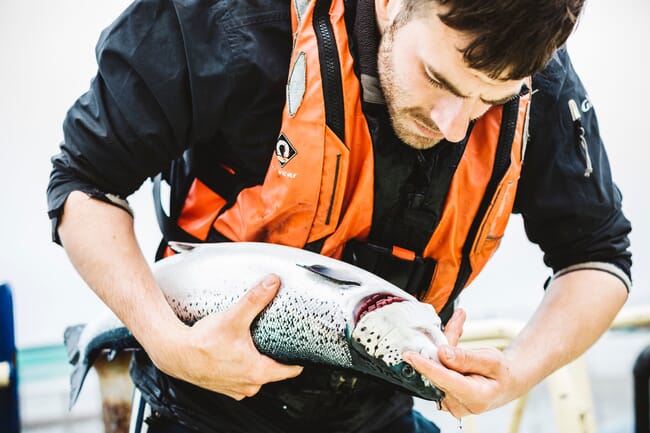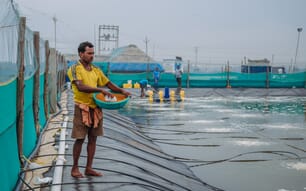
An Iowa State University professor is partnering with Norwegian researchers to study whether rising disease rates in salmon raised in massive sea pens might be caused by stress hormones from increasingly intensive handling methods © Snorre Gulla
Salmon aquaculture is a crucial industry in Norway, so it’s alarming that instances of bacterial diseases are increasing on farm sites. To help explain why, the country’s top veterinary research centre is turning to Mark Lyte, a professor of veterinary microbiology and preventive medicine at Iowa State University. His theory? The salmon are stressed out.
New stress for salmon
Norwegian salmon farmers once heavily used antibiotics and other medicines. But their disease control efforts now rely largely on vaccines and physically delousing the fish, a handling practice that has become more common in recent years as sea lice have become resistant to chemical treatments. Physical delousing methods include brushing lice off the scales of salmon and exposing the cold-water fish to warm water.
“All of that is surely very stressful to the fish. Imagine if you were parboiled for a while. You wouldn’t like it. And then we ask, ‘What is part of the stress response?’ Neurochemicals,” Lyte said.
Those neurochemicals – “fight or flight” stress hormones such as norepinephrine and epinephrine – prompt physical reactions such as an increased heart rate and blood sugar levels, preparing an animal to act. But that stimulation can extend beyond the stressed animal.

Delousing methods prompt a stress response in salmon, which could potentially trigger bacteria growth © Scottish Sea Farms
Lyte pioneered microbial endocrinology, a research field that combines microbiology and neurobiology to study the interactions between microorganisms, animals and plants – many of which produce and respond to the same neurochemicals. One of his discoveries revealed how hormones produced by a stressful condition could lead to deadly infections by acting as an environmental signal to bacteria, causing them to proliferate and attach to host tissue long before the host’s immune system realises they are there. Recognising and responding to a host’s stress response enables pathogens to evade immune systems and ultimately cause disease.
That’s what Lyte and researchers from the Norwegian Veterinary Institute (NVI) suspect may be happening at Norway’s salmon farms. Stress hormones produced by the fish could be promoting bacterial growth, leading to increased infections.
A signal to grow
Lyte first showed more than 30 years ago that bacteria can respond to neurochemicals involved in the stress response. Knowing that stress hormones can turbocharge bacterial growth was instrumental in finally understanding why hospital patients who receive synthetic forms of stress hormones to boost their heart and kidney function can develop life-threatening infections.
He developed the theory of microbial endocrinology after years of researching the ability of stress to suppress the immune system. He found that from an evolutionary perspective, it didn’t make sense for acute stress to suppress a host’s immune system.
“Two animals fight and bite each other. The skin of one animal is punctured, allowing bacteria get in. At that point, why would it be in the best interest for the stressed animal with the puncture to have its immune system suppressed and not fight off the bacteria in the wound? Obviously, evolution would not have selected for that to happen,” he said. “Instead, the animal’s immune system would gear up to fight off potential invaders. So stress may be good for the immune response, initially, when an animal is faced with a challenge.”
The trouble is bacteria also want to survive. That’s why infections can ramp up even in the face of a heightened immune response. The bacteria sense the stress hormones as an environmental signal to start growing faster and adhering to surfaces to make biofilms, which enable the bacteria to fend off attacks from immune cells and antibiotics given to treat the infection.
“Dealing with the stress response is nothing new to these bugs. They’ve seen these neurochemicals before fish and other animals ever existed, and they change their physiology to survive,” Lyte said.

Infections can ramp up even in the face of a heightened immune response
Research into how microorganisms interact and impact host animals is rapidly expanding, but much remains unknown. For instance, Lyte said, scientists discovered in the 1940s that a probiotic common in yogurt, lactobacillus, produces large amounts of gamma-aminobutyric acid, which is a major neurotransmitter in animal brains.
“Decades later, it’s still unclear why,” he said. “It’s not just for the heck of it. They’re doing it for a reason.”
Extending to fish
Lyte’s research team is partnering with the NVI on a three-year, $1.2 million grant from the Research Council of Norway, the first collaboration between the two institutions. The researchers hope to establish whether stress hormones are making farmed salmon more susceptible to bacterial disease, which costs the industry an estimated $100 million per year.
The outbreaks involve numerous pathogens, both re-emerging and new concerns, but there’s no indication of any decisive genetic changes in the bacteria or the fish, which are bred for disease resistance. The environment in the sea cages, including the water temperature, has remained steady. However, the spike in disease rates in recent years coincides with the steep rise in physical delousing and symptoms often appear shortly after the treatments, which can be conducted as frequently as every month during the summer, said Dr Snorre Gulla, a senior researcher at NVI.

The research trial will expose fish-associated bacteria to stress hormones in a lab and then begin exploring the response of stressed fish in water © Uli Kunz, Veramaris
Starting in July, Lyte will travel to Norway to meet and train Norwegian researchers, who will later visit his lab in Ames, Iowa. The research will involve exposing fish-associated bacteria to stress hormones in a lab and to stressed fish in water. The team also aims to develop tools for monitoring stress hormone levels in salmon stocks.
“Our overall ambition is to create new knowledge and increased understanding of important bacterial diseases in Norwegian aquaculture through unravelling whether microbial endocrinological processes are important facilitators of bacterial diseases in fish. This can hopefully lead to better mitigation strategies,” Gulla said.
Connecting the salmon disease outbreak to stress hormones also would be another step in Lyte’s efforts to show the infectious interaction in a variety of animal species.
“If you can prove this across an evolutionary spectrum, you have a better understanding of how it works in humans,” he said.




